-
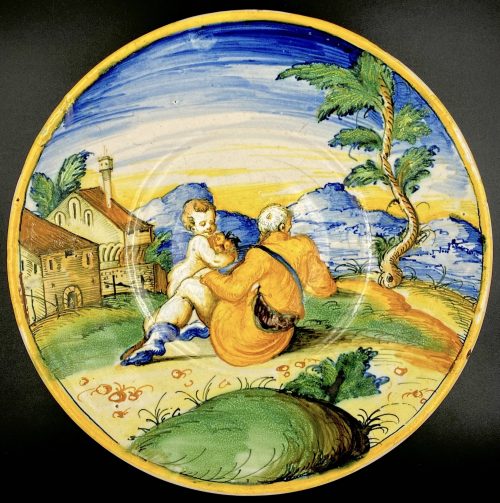
-
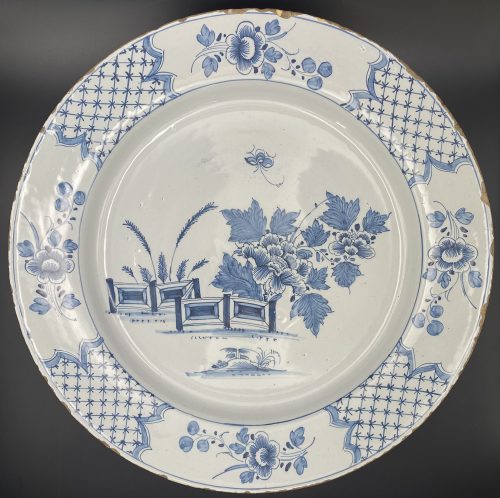 Round plate with a blue and white design of blossoming peony behind a fence with lattice and floral border; flowers to the bottom. Diameter: 33 cm, Haight: 4.5 cm.
Round plate with a blue and white design of blossoming peony behind a fence with lattice and floral border; flowers to the bottom. Diameter: 33 cm, Haight: 4.5 cm. -
 Iron tsuba of the round form (maru gata) with a grey patina pierced with the design of slanting rays of light (Jesuit’s IHS symbol) and a pair of ginger symbols [茗荷] (myōga) at top and bottom, in positive silhouette (ji-sukashi). This design is often called “tokei” [時計] or “clock gear”. Rounded rim, large hitsu-ana, copper fittings (sekigane). Unsigned, unpapered. Owari school. Early Edo period, early 17th century.
Iron tsuba of the round form (maru gata) with a grey patina pierced with the design of slanting rays of light (Jesuit’s IHS symbol) and a pair of ginger symbols [茗荷] (myōga) at top and bottom, in positive silhouette (ji-sukashi). This design is often called “tokei” [時計] or “clock gear”. Rounded rim, large hitsu-ana, copper fittings (sekigane). Unsigned, unpapered. Owari school. Early Edo period, early 17th century.Size: H 71.9 x W 71.1 x Th (centre) 5.5 cm.
For information regarding this type of tsuba see the article 'Kirishitan Ikenie Tsuba by Fred Geyer at Kokusai Tosogu Kai; The 2nd International Convention & Exhibition, October 18-23, 2006, pp. 84-91. 
IHS emblem of the Jesuits

茗荷 Myoga or Japanese ginger
-
 Iron tsuba of slightly elongated round form decorated with design of melon flowers, vines, and leaves in brass flat inlay (hira-zōgan) on both sides. Slightly raised rim (mimi) carved in a way to simulate ring-shaped covering (fukurin). Kozuka hitsu-ana and kogai hitsu-ana both plugged with soft metal (tim or lead). Copper sekigane. Heianjō or Kaga School. Muromachi or Momoyama period, 16th century. Iron, hira-zōgan brass inlay. Round (maru gata) form, diameter 79 mm. Size: 80.3 x 78.4 mm; thickness at seppa-dai: 3.4 mm; at the middle: 3.8 mm; before the rim: 2.4 mm, rim: 2.8 mm. Note on design: though this design resembles family crests with oak and mulberry leaves, I believe it's a melon flower [see Jeanne Allen. Designer's guide to Samurai Patterns. Chronicle Books, San Francisco, 1990, page 114, №130 "Melon Flowers":Note about the distribution of thickness (niku-oki): "this tsuba has toroid features, niku raises from the rim towards the centre but thins once more out when approaching the seppa-dai" [M. Sesko, "Handbook...", p. 48].
Iron tsuba of slightly elongated round form decorated with design of melon flowers, vines, and leaves in brass flat inlay (hira-zōgan) on both sides. Slightly raised rim (mimi) carved in a way to simulate ring-shaped covering (fukurin). Kozuka hitsu-ana and kogai hitsu-ana both plugged with soft metal (tim or lead). Copper sekigane. Heianjō or Kaga School. Muromachi or Momoyama period, 16th century. Iron, hira-zōgan brass inlay. Round (maru gata) form, diameter 79 mm. Size: 80.3 x 78.4 mm; thickness at seppa-dai: 3.4 mm; at the middle: 3.8 mm; before the rim: 2.4 mm, rim: 2.8 mm. Note on design: though this design resembles family crests with oak and mulberry leaves, I believe it's a melon flower [see Jeanne Allen. Designer's guide to Samurai Patterns. Chronicle Books, San Francisco, 1990, page 114, №130 "Melon Flowers":Note about the distribution of thickness (niku-oki): "this tsuba has toroid features, niku raises from the rim towards the centre but thins once more out when approaching the seppa-dai" [M. Sesko, "Handbook...", p. 48].
Jeanne Allen. Designer's guide to Samurai Patterns. Chronicle Books, San Francisco, 1990. Page 114, №130.
-
 Onin Tsuba with two overlapping lozenges, or interlocked diamond shapes. Iron and brass. Sukashi and ten-zogan technique. Muromachi period. Diameter: 81.0 mm; Thickness at seppa-dai: 3.2 mm The symbol of two overlapping lozenges (or, interlocked diamond shapes), presumably a family crest (kamon) may be deciphered as chigai kuginuki (nail extraction tool => 'conquered nine castles' ) or as chigai bishi (overlapping lozenges). Similar symbol can be found at Butterfield & Butterfield. IMPORTANT JAPANESE SWORDS, SWORD FITTINGS AND ARMOR. Auction Monday, November 19th, 1979. Sale # 3063], №94 with the following explanation: " This was the mon (crest) of the Yonekura family of Kaga Prov., at Kanazawa". An interesting insight is provided by Robert E. Haynes at Important Japanese kodogu, gaiso and works of art. San Francisco, April 9-11, 1982. Robert E. Haynes, Ltd., № 36 (see photo): "This would seem to be the Yonekura family mon. They were Seiwa-Genji Daimyō family made noble in 1696 and resided in Kanazawa in Kaga". Would it be possible that this is a late 17th century Ōnin tsuba?
Onin Tsuba with two overlapping lozenges, or interlocked diamond shapes. Iron and brass. Sukashi and ten-zogan technique. Muromachi period. Diameter: 81.0 mm; Thickness at seppa-dai: 3.2 mm The symbol of two overlapping lozenges (or, interlocked diamond shapes), presumably a family crest (kamon) may be deciphered as chigai kuginuki (nail extraction tool => 'conquered nine castles' ) or as chigai bishi (overlapping lozenges). Similar symbol can be found at Butterfield & Butterfield. IMPORTANT JAPANESE SWORDS, SWORD FITTINGS AND ARMOR. Auction Monday, November 19th, 1979. Sale # 3063], №94 with the following explanation: " This was the mon (crest) of the Yonekura family of Kaga Prov., at Kanazawa". An interesting insight is provided by Robert E. Haynes at Important Japanese kodogu, gaiso and works of art. San Francisco, April 9-11, 1982. Robert E. Haynes, Ltd., № 36 (see photo): "This would seem to be the Yonekura family mon. They were Seiwa-Genji Daimyō family made noble in 1696 and resided in Kanazawa in Kaga". Would it be possible that this is a late 17th century Ōnin tsuba?
Robert E. Haynes Catalog of April 9-11, 1982, № 36.
-
 Iron tsuba of half round and half lobed (chrysanthemoid) form decorated with plants and family crests (mon) in cast brass inlay (suemon-zōgan), and scattered brass dots inlay (ten-zōgan); brass wire inlay outlining the rim, seppa-dai, and hitsu-ana (scalloped wire) on both sides. Surface treated with hummer punch marks. The chrysanthemoid half of the plate chiseled with thin shallow grooves, outlining the petals. Copper sekigane. On the face the inlay represents: mandarin orange (tachibana), half karahana, encircled bellflower, and four encircled three-stipe family crest (mitsubiki-mon of Sakuma and Abe clans, and some others). On the reverse the design is similar but two of the mitsubiki-mon symbols replaced with two comb-shaped Genji-mon ideographs. Ōnin school. The end of mid-Muromachi period, beginning of the 16th century. Size: 74.3 x 72.7 x 2.4 mm.
Iron tsuba of half round and half lobed (chrysanthemoid) form decorated with plants and family crests (mon) in cast brass inlay (suemon-zōgan), and scattered brass dots inlay (ten-zōgan); brass wire inlay outlining the rim, seppa-dai, and hitsu-ana (scalloped wire) on both sides. Surface treated with hummer punch marks. The chrysanthemoid half of the plate chiseled with thin shallow grooves, outlining the petals. Copper sekigane. On the face the inlay represents: mandarin orange (tachibana), half karahana, encircled bellflower, and four encircled three-stipe family crest (mitsubiki-mon of Sakuma and Abe clans, and some others). On the reverse the design is similar but two of the mitsubiki-mon symbols replaced with two comb-shaped Genji-mon ideographs. Ōnin school. The end of mid-Muromachi period, beginning of the 16th century. Size: 74.3 x 72.7 x 2.4 mm. -

Iron tsuba of mokko form with rough surface decorated in low relief carving (sukidashi-bori) and openwork (sukashi) with a flying bat, a crescent moon, and a cloud over the moon. Bat's eyes inlaid with gold. Crescent moon and cloud on the reverse. Copper sekigane. Kogai hitsu-ana plugged with shakudō.
Unsigned.
Edo period.Size: Height: 83.7 mm; Width: 80.3 mm; Thickness: 2.9 mm; Weight: 141 g.
-
 Iron tsuba of octafoil form with design of rudder (kaji) and lake in openwork (sukashi) outlined with brass wire. Thin plate also decorated with three concentric circular rows of brass dots (nail heads) in ten-zōgan. Center of the plate outlined with the inlaid circular brass wire. Cut-outs for kozuka and kogai probably added later. Slightly raised rim between the indentations (suki-nokoshi-mimi). The inlaid metal of red-ish hue, so it may be copper, not brass. Sekigane, visible on the NBTHK paper photo, are missing, possibly removed by a previous owner. Muromachi period. Ōnin school. Unsigned. Dimensions: 81.2 mm x 81.8 mm x 2.7 mm. Weight: 79.0 g. Large nakago-ana: 34 mm high and 10 mm wide. NBTHK certificate №455786: Hozon. Note regarding design: it was quite hard to interpret the big oval opening. The first suggestion was 'sea cucubmer', and it was based on a design published by Kazutaro Torigoye [Kodogu and tsuba. International collections not published in my books (Toso Soran), 1978] on page 202: Katchūshi tsuba: Sea cucumber and butterfly. Look and judge yourself:The second suggestion - 'lake' - came from [Iron tsuba. The works of the exhibition "Kurogane no hana", The Japanese Sword Museum, 2014], page 14 №5:
Iron tsuba of octafoil form with design of rudder (kaji) and lake in openwork (sukashi) outlined with brass wire. Thin plate also decorated with three concentric circular rows of brass dots (nail heads) in ten-zōgan. Center of the plate outlined with the inlaid circular brass wire. Cut-outs for kozuka and kogai probably added later. Slightly raised rim between the indentations (suki-nokoshi-mimi). The inlaid metal of red-ish hue, so it may be copper, not brass. Sekigane, visible on the NBTHK paper photo, are missing, possibly removed by a previous owner. Muromachi period. Ōnin school. Unsigned. Dimensions: 81.2 mm x 81.8 mm x 2.7 mm. Weight: 79.0 g. Large nakago-ana: 34 mm high and 10 mm wide. NBTHK certificate №455786: Hozon. Note regarding design: it was quite hard to interpret the big oval opening. The first suggestion was 'sea cucubmer', and it was based on a design published by Kazutaro Torigoye [Kodogu and tsuba. International collections not published in my books (Toso Soran), 1978] on page 202: Katchūshi tsuba: Sea cucumber and butterfly. Look and judge yourself:The second suggestion - 'lake' - came from [Iron tsuba. The works of the exhibition "Kurogane no hana", The Japanese Sword Museum, 2014], page 14 №5:
Torigoye: sea cucumber and butterfly.
Opening on my tsuba looks more like the 'lake'. Also, rudder and lake make more sense than rudder and sea cucumber. At least to me...
Ko-Katchūshi tsuba: Lake and pine.
-
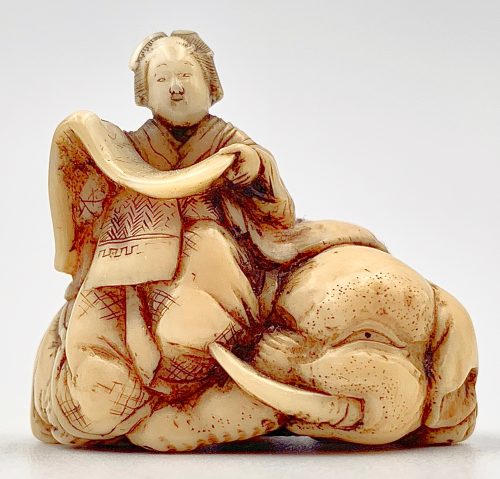 Netsuke of Kimi no Eguchi on a recumbent elephant. Signed: Toun. Circa 1850. 33.7 x 30.8 x 22.7 mm. The Courtesan Eguchi no kimi as Fugen, Bodhisattva of Universal Wisdom (Eguchi no kimi mitate Fugen Bosatsu). The imagery satirizes the Buddhist bodhisattva Fugen, whose iconographic mount is an elephant, by replacing the deity with a beautifully coiffed modern courtesan. Such a visual pun (mitate) was an artistic trope, popular in the Edo period. Provenance: Charles Ephrussi (1849-1905) acquired in the 1870s; a wedding gift in 1898 to his cousin Ritter Viktor von Ephrussi (1860-1945) and Baroness Emilie (Emmy) Schey von Koromla (1879-1938); retrieved post-war by their daughter Elizabeth de Waal (1899-1991); given by her to her brother Ignaz (Iggie) Ephrussi (1906-1994), Tokyo; bequeathed by him to his great-nephew Edmund de Waal (born 1964), London, author of "The Hare with Amber Eyes: a hidden inheritance". London / New York: Chatto & Windus / Farrar, Straus & Giroux. ISBN 978-0099539551. https://en.wikipedia.org/wiki/Charles_Ephrussi. https://en.wikipedia.org/wiki/Ephrussi_family. https://en.wikipedia.org/wiki/Edmund_de_Waal.
Netsuke of Kimi no Eguchi on a recumbent elephant. Signed: Toun. Circa 1850. 33.7 x 30.8 x 22.7 mm. The Courtesan Eguchi no kimi as Fugen, Bodhisattva of Universal Wisdom (Eguchi no kimi mitate Fugen Bosatsu). The imagery satirizes the Buddhist bodhisattva Fugen, whose iconographic mount is an elephant, by replacing the deity with a beautifully coiffed modern courtesan. Such a visual pun (mitate) was an artistic trope, popular in the Edo period. Provenance: Charles Ephrussi (1849-1905) acquired in the 1870s; a wedding gift in 1898 to his cousin Ritter Viktor von Ephrussi (1860-1945) and Baroness Emilie (Emmy) Schey von Koromla (1879-1938); retrieved post-war by their daughter Elizabeth de Waal (1899-1991); given by her to her brother Ignaz (Iggie) Ephrussi (1906-1994), Tokyo; bequeathed by him to his great-nephew Edmund de Waal (born 1964), London, author of "The Hare with Amber Eyes: a hidden inheritance". London / New York: Chatto & Windus / Farrar, Straus & Giroux. ISBN 978-0099539551. https://en.wikipedia.org/wiki/Charles_Ephrussi. https://en.wikipedia.org/wiki/Ephrussi_family. https://en.wikipedia.org/wiki/Edmund_de_Waal. -
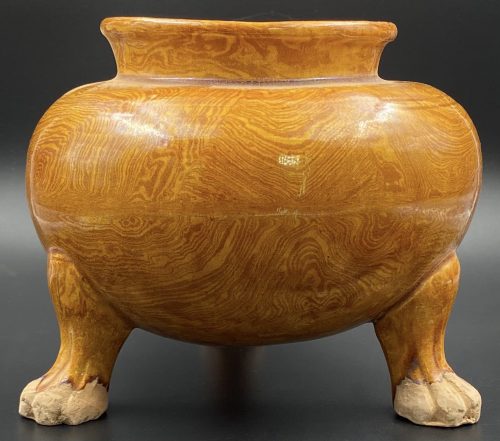 Amber-glazed marbled pottery tripod censer, standing on unglazed beast's paws. The clay itself is not marbled, only the glaze. China, the Tang dynasty [唐朝] (618 – 907). Diameter: 16 cm; Height: 14 cm.
Amber-glazed marbled pottery tripod censer, standing on unglazed beast's paws. The clay itself is not marbled, only the glaze. China, the Tang dynasty [唐朝] (618 – 907). Diameter: 16 cm; Height: 14 cm. -
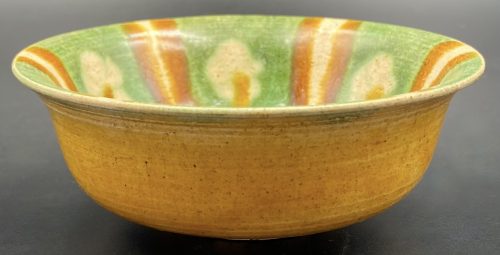 Small stoneware cup with rounded sides raising from a short foot to an inverted rim; glazed inside with a cream and brown six-petal design on a green background with cream and brown stylized flowers. Amber glaze outside, blue bottom, foot unglazed. Dia: 10 cm; H: 4 cm.
Small stoneware cup with rounded sides raising from a short foot to an inverted rim; glazed inside with a cream and brown six-petal design on a green background with cream and brown stylized flowers. Amber glaze outside, blue bottom, foot unglazed. Dia: 10 cm; H: 4 cm. -
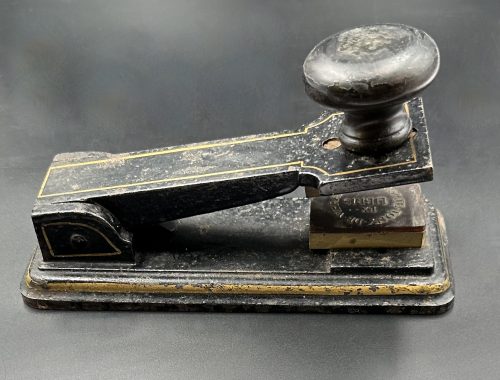 Iron pliers painted black and outlined in gilt lacquer, with wooden handle and bronze seals, "Ex Libris Comte Tony de Vibraye", L17.1 x W6.9 x H7.5 cm. Provenance: Antoine Henri Gaston Hurault de Vibraye [Comte Tony de Vibraye] (French, 1893 – 1951). The book with such a stamp in this library: [LIB-3243.2023] Crébillon fils. La Nuit et le moment ou Les Matinées de Cythère / Illustrations de Sylvain Sauvage. — Paris: Au dépens d’un amateur, 1924.
Iron pliers painted black and outlined in gilt lacquer, with wooden handle and bronze seals, "Ex Libris Comte Tony de Vibraye", L17.1 x W6.9 x H7.5 cm. Provenance: Antoine Henri Gaston Hurault de Vibraye [Comte Tony de Vibraye] (French, 1893 – 1951). The book with such a stamp in this library: [LIB-3243.2023] Crébillon fils. La Nuit et le moment ou Les Matinées de Cythère / Illustrations de Sylvain Sauvage. — Paris: Au dépens d’un amateur, 1924. -
 A yamagane (unrefined copper) ko-kinko tsuba of slightly elongated round form with design of wisteria carved in sculptural relief (nikubori). Copper sekigane. Unsigned. Muromachi period, likely the 16th century.
A yamagane (unrefined copper) ko-kinko tsuba of slightly elongated round form with design of wisteria carved in sculptural relief (nikubori). Copper sekigane. Unsigned. Muromachi period, likely the 16th century.Size: 74.3 x 71.8 x 3.2 mm.
NBTHK certificate №4003986: Hozon (worthy preservation). In custom wooden box. -
 Iron tsuba of oval form with design of stylized paulownia (nage-giri) in openwork (sukashi). Leaf veins carved in kebori technique. Rounded rim. Copper sekigane. Unsigned. Attributed to Kanshirō, third generation Nishigaki (1680-1761). Edo period: Early 18th century (Kyoho / Genbun era). Size: Height: 77.8 mm. Width: 71.9 mm. Rim thickness: 5.9 mm. Center thickness: 5.0 mm. Provenance: Sasano Masayuki Collection, № 264: "Nishigaki. Third generation Kanshiro (died in in the eleventh year of Hohreki, 1761 at the age of eighty-two). This oblong shape appears a little amateurish at first, however, it was done intentionally to add flavor to to the design. The neat composition is a feature of the third Kanshiro."
Iron tsuba of oval form with design of stylized paulownia (nage-giri) in openwork (sukashi). Leaf veins carved in kebori technique. Rounded rim. Copper sekigane. Unsigned. Attributed to Kanshirō, third generation Nishigaki (1680-1761). Edo period: Early 18th century (Kyoho / Genbun era). Size: Height: 77.8 mm. Width: 71.9 mm. Rim thickness: 5.9 mm. Center thickness: 5.0 mm. Provenance: Sasano Masayuki Collection, № 264: "Nishigaki. Third generation Kanshiro (died in in the eleventh year of Hohreki, 1761 at the age of eighty-two). This oblong shape appears a little amateurish at first, however, it was done intentionally to add flavor to to the design. The neat composition is a feature of the third Kanshiro." -
 Mokkō form iron tsuba carved in relief and inlaid with soft metals (copper, gold, silver) with the design of a cormorant fisherman on the face and a boat on the reverse. Unsigned. Dimensions: 77 mm x 69 mm x 3.0 mm (at seppa-dai) Edo period: 18th or 19th century. "Since Nara period, Japanese fishermen in small boats have used cormorants (u) to catch river fish at night, binding the necks of the birds so that the fish are not swallowed. [...] The bird and the work it performs are symbols of selfless devotion to one's master and keen eyesight." - from Merrily Baird. Symbols of Japan. Thematic motifs in art and design. Rizzoli international publications, Inc., 2001; p. 104. See also in this collection TSU-0212 and TSU-0241.
Mokkō form iron tsuba carved in relief and inlaid with soft metals (copper, gold, silver) with the design of a cormorant fisherman on the face and a boat on the reverse. Unsigned. Dimensions: 77 mm x 69 mm x 3.0 mm (at seppa-dai) Edo period: 18th or 19th century. "Since Nara period, Japanese fishermen in small boats have used cormorants (u) to catch river fish at night, binding the necks of the birds so that the fish are not swallowed. [...] The bird and the work it performs are symbols of selfless devotion to one's master and keen eyesight." - from Merrily Baird. Symbols of Japan. Thematic motifs in art and design. Rizzoli international publications, Inc., 2001; p. 104. See also in this collection TSU-0212 and TSU-0241. -
 Iron tsuba of 14-petal chrysanthemoid form (kikka-gata) with alternating solid and openwork petals, the latter outlined with brass wire (sen-zōgan) and the former decorated with brass dots (ten-zōgan), on both sides. Seppa-dai is outlined with brass wire. Small hitsu-ana probably cut later. Late Muromachi period (Ca. 1514-1573). Ōnin school. Unsigned. Dimensions: 87.0 x 87.8 x 3.2 mm. Similar tsuba in this collection: TSU-0420.2022
Iron tsuba of 14-petal chrysanthemoid form (kikka-gata) with alternating solid and openwork petals, the latter outlined with brass wire (sen-zōgan) and the former decorated with brass dots (ten-zōgan), on both sides. Seppa-dai is outlined with brass wire. Small hitsu-ana probably cut later. Late Muromachi period (Ca. 1514-1573). Ōnin school. Unsigned. Dimensions: 87.0 x 87.8 x 3.2 mm. Similar tsuba in this collection: TSU-0420.2022 Other similar specimens can be found at:
Henri L. Joly and Kumasaku Tomita, Japanese art and handicraft, "Swords and sword fittings" section, sub-section “Inlays of Ōnin, Kyoto, Fushimi-Yoshiro, and Kaga Province”, Plate CX, #128: Iron, chrysanthemoid, thin guard with alternate petals covered with brass spots. Ōnin style. 16th century.
Compton Collection, Part I, #7: The iron plate is of flowerhead shape with each of the fourteen petals alternating between solid and openwork. The apertures are outlined in inlaid brass as is the seppa-dai and hitsu-ana. The remainder of the plate is similarly inlaid with plum flowers, birds, dots of dew, Genji mon and sambiki mon. 87 mm x 85 mm x 3.5 mm.
Other similar specimens can be found at:
Henri L. Joly and Kumasaku Tomita, Japanese art and handicraft, "Swords and sword fittings" section, sub-section “Inlays of Ōnin, Kyoto, Fushimi-Yoshiro, and Kaga Province”, Plate CX, #128: Iron, chrysanthemoid, thin guard with alternate petals covered with brass spots. Ōnin style. 16th century.
Compton Collection, Part I, #7: The iron plate is of flowerhead shape with each of the fourteen petals alternating between solid and openwork. The apertures are outlined in inlaid brass as is the seppa-dai and hitsu-ana. The remainder of the plate is similarly inlaid with plum flowers, birds, dots of dew, Genji mon and sambiki mon. 87 mm x 85 mm x 3.5 mm.
Japanese art and handicraft, Plate CX, #128.
And at Jim Gilbert website: Onin ten zogan tsuba, mid Muromachi. Size: 7.7 cm T x 7.6 cm W x 0.3 cm. Iron plate with brass inlay. Kiku gata. The Ōnin ten zogan style is characterized by the decoration of small brass “nail heads” and wires on a thin iron plate. The iron often has a soft, granular texture and seems to be prone to rust. Unfortunately, this rust will undermine the brass inlay and result in the loss of some of the inlay. This example is in reasonably good but far from perfect condition. As is often the case, the backside is better preserved, with the wire around the seppa-dai and kozuka-ana, and all petals still intact.
Compton Collection, Part I, #7.
-

Iron tsuba with hammer marked surface and design of a plum and cherry blossoms to the right of nakaga-ana in openwork (sukashi). Raised rim, typical to katchushi school. The thickness of the plate provides for later Muromachi period making.
Late Muromachi period (1514-1573). Size: 85.8 x 85.0 x 3.6 (center), 4.1 (rim) mm; weight: 136 g. -
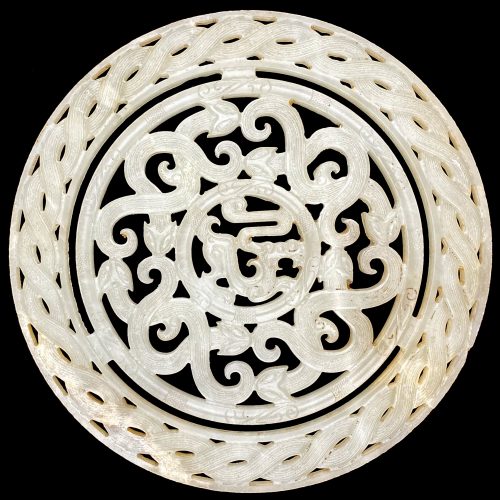 White jade Bi of three concentrical circles: double helix outer, intertwined serpents in the middle and a dragon in centre, carved in openwork and low-relief. China, the Ming Dynasty [大明] (1368 – 1644). Diameter: 15.9 cm; Height: 0.5 cm.
White jade Bi of three concentrical circles: double helix outer, intertwined serpents in the middle and a dragon in centre, carved in openwork and low-relief. China, the Ming Dynasty [大明] (1368 – 1644). Diameter: 15.9 cm; Height: 0.5 cm. -
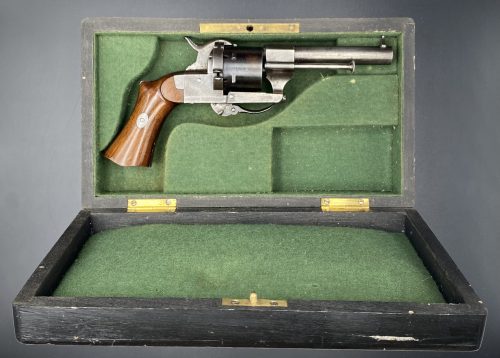
Lefaucheux model 1858 pin-fire self-cocking revolver with ejector rod, folding trigger and polished walnut grips, manufactured in Paris.
Stamped on barrel: E. LEFAUCHEUX BRte S.G.D.G. À PARIS.
Serial number LF 9018; in a wooden case. Dimensions: Case: 23 x 13 x 6 cm; L: 20.5 cm; H: 9 cm; Barrel: 9 cm. Eugene Lefaucheux (French, 1820 – 1871) was the son of Casimir Lefaucheux (French, 1802 – 1852). -
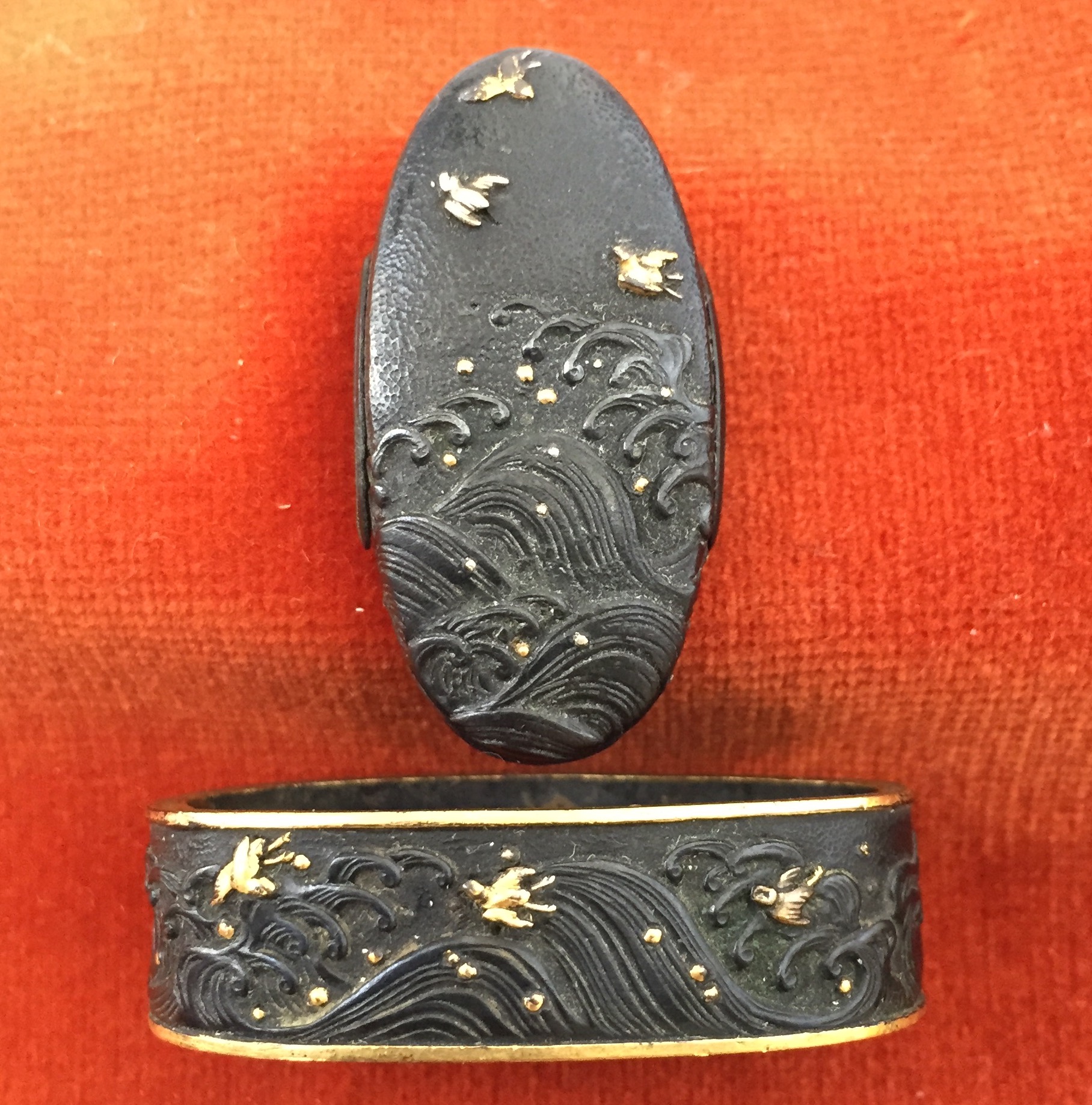 Fuchi: 37 x 21 x 11 mm; Weight: 13 g Kashira: 34 x 16 x 6 mm ; Weight: 10 g Material : Shakudo; Gold. Signature: Unsigned Technique: Sunameji Sukibori Zogan Decoration: Nami Chidori zu (wave & plover)
Fuchi: 37 x 21 x 11 mm; Weight: 13 g Kashira: 34 x 16 x 6 mm ; Weight: 10 g Material : Shakudo; Gold. Signature: Unsigned Technique: Sunameji Sukibori Zogan Decoration: Nami Chidori zu (wave & plover) -
 Iron tsuba of round form with design of slanting rays of light (shakoh) or clock gear (tokei) in openwork (sukashi). Commonly considered a Christian / Jesuit motif. Round-cornered rim. Copper sekigane. Momoyama period: Late 16th century (Tensho/Keicho era). Height: 72.5 mm, Width: 72.2 mm, Rim thickness: 5.5 mm, Center thickness: 5.3 mm. Round-cornered rim. Provenance: Sasano collection. Sasano Masayuki, Japanese Sword Guards Masterpieces from The Sasano Collection, Part I, № 136: "The general belief that this design represents the gear of a clock is erroneous, rather it shows the slanting rays of light from a cross, with the small diamond shapes representing the upright and transverse bars. The Christian influence is obvious..."
Iron tsuba of round form with design of slanting rays of light (shakoh) or clock gear (tokei) in openwork (sukashi). Commonly considered a Christian / Jesuit motif. Round-cornered rim. Copper sekigane. Momoyama period: Late 16th century (Tensho/Keicho era). Height: 72.5 mm, Width: 72.2 mm, Rim thickness: 5.5 mm, Center thickness: 5.3 mm. Round-cornered rim. Provenance: Sasano collection. Sasano Masayuki, Japanese Sword Guards Masterpieces from The Sasano Collection, Part I, № 136: "The general belief that this design represents the gear of a clock is erroneous, rather it shows the slanting rays of light from a cross, with the small diamond shapes representing the upright and transverse bars. The Christian influence is obvious..." -
 Iron tsuba of round form decorated with eight roundels - circular emblems of flowers and/or family crests (mon) made of cast brass, pierced and chiseled in kebori, and with flat brass inlay (hira-zōgan) of vines or seaweed all over the plate. Hitsu-ana outlined in brass. Four positive silhouette roundels are 3-, 4-, 5-, and 6- pointing crests/flowers; four negative silhouette roundels are bellflower, cherry blossom, and suhama. Yoshirō school (Kaga-Yoshirō). The Momoyama or early Edo period, beginning of 17th century. Size: diameter 77 mm, thickness 3,8 mm
Iron tsuba of round form decorated with eight roundels - circular emblems of flowers and/or family crests (mon) made of cast brass, pierced and chiseled in kebori, and with flat brass inlay (hira-zōgan) of vines or seaweed all over the plate. Hitsu-ana outlined in brass. Four positive silhouette roundels are 3-, 4-, 5-, and 6- pointing crests/flowers; four negative silhouette roundels are bellflower, cherry blossom, and suhama. Yoshirō school (Kaga-Yoshirō). The Momoyama or early Edo period, beginning of 17th century. Size: diameter 77 mm, thickness 3,8 mm -
 Iron tsuba of four-lobbed mokkō form decorated in brass and shakudō inlay on the face with design of rotten skull, fly, maple leaf, pine cones and needles, and on the back with design of rotten skull, wild boar, pine cones and needles. Scattered brass dots on both sides. Hitsu-ana possibly cut off later. Surface has traces of lacquer (urushi). Momoyama period. Dimensions: 67.3 x 61.5 x 4.3 mm A similar example can be found at Tsuba Kanshoki by Kazutaro Torogoye, 1975 on p. 61: "Heianjōzōgan tsuba. No sig. Iron: Pine-cone, seeds, ants & rock, brass zōgan. Kakumimi: C. 1.5 bu. Age: Momoyama. Sup. - Early work. Interest."
Iron tsuba of four-lobbed mokkō form decorated in brass and shakudō inlay on the face with design of rotten skull, fly, maple leaf, pine cones and needles, and on the back with design of rotten skull, wild boar, pine cones and needles. Scattered brass dots on both sides. Hitsu-ana possibly cut off later. Surface has traces of lacquer (urushi). Momoyama period. Dimensions: 67.3 x 61.5 x 4.3 mm A similar example can be found at Tsuba Kanshoki by Kazutaro Torogoye, 1975 on p. 61: "Heianjōzōgan tsuba. No sig. Iron: Pine-cone, seeds, ants & rock, brass zōgan. Kakumimi: C. 1.5 bu. Age: Momoyama. Sup. - Early work. Interest."
Tsuba Kanshoki, 1975, p. 61: Heianjō tsuba, Momoyama Period.
-

Iron tsuba of round form pierced (sukashi) and carved (marubori) with a 'noshi' decoration design. Noshi - decoration made of dried abalone (awabi) and bearing an auspicious connotation of good fortune, prosperity, etc. Design was used as a family crest (mon).
Size: 76.3 x 75.9 x 5.5 mm.
Signed: Echizen jū Kinai Saku. Kinai school existed from mid 17th to mid 19th century; it is hard to tell which master (generation from 1 to 6) made this particular piece.
SOLD -

Iron tsuba of square with cut-off edges form (sumi-iri-kakugata) with lattice design in openwork (sukashi) and pierced center.
Unsigned. Late Muromachi period, ca. 16th century.
Size: 73.2 x 72.4 x 3.6 mm References: 1) Tsuba Kanshoki. Kazutaro Torogoye, 1975, p. 95, lower image. It's also called Kyō shōami. 2) KTK-11: Koshi motif, Late Muromachi (16th c.) -
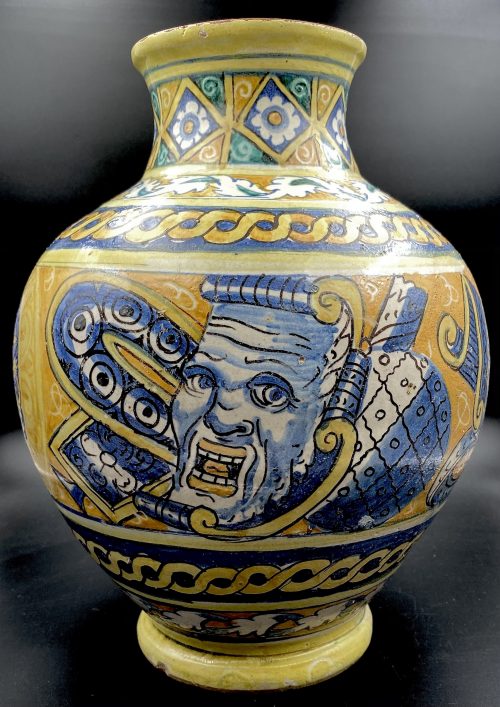
-

Iron tsuba of mokko form decorated with arabesque (karakusa) in low relief carving. niku from 4.0 mm in the centre to 5.1 mm at the rim. Strong Nobuie [信家] signature (futoji-mei) to the left of nakago-ana. Hitsuana plugged with pewter.
Size: H: 88.2 mm, W: 83.6, Th(c): 4.0 mm, Th(r): 5.1 mm Weight: 167 g.Signed: Nobuie [信家]
Probably the work of Nidai Nobuie (c. 1600).
Tokubetsu hozon certificate № 229324 of the N.B.T.H.K., dated 22.12.2010 -
 A ko-tosho tsuba made of iron, of the round form (丸型, maru-gata), pierced in negative silhouette (文透, mon-sukashi) with the design of Shingon Buddhism symbols of vajra [金剛杵] (kongosho), Sun, Moon and Star [月日星] (tsuki-hi-hoshi) – three sources of light [三光] (sankō). Round rim. No hitsu-ana; the shape of nakago-ana may suggest use on naginata [薙刀. Muromachi period (1393 – 1573). Height: 94.4 mm, Width: 93.4 mm, Centre thickness: 3.1 mm. Another possible explanation for "The element at the 11-o’clock position is in my opinion a kemari ball for the courtly game of the same name (picture attached)" [Markus Sesko].
A ko-tosho tsuba made of iron, of the round form (丸型, maru-gata), pierced in negative silhouette (文透, mon-sukashi) with the design of Shingon Buddhism symbols of vajra [金剛杵] (kongosho), Sun, Moon and Star [月日星] (tsuki-hi-hoshi) – three sources of light [三光] (sankō). Round rim. No hitsu-ana; the shape of nakago-ana may suggest use on naginata [薙刀. Muromachi period (1393 – 1573). Height: 94.4 mm, Width: 93.4 mm, Centre thickness: 3.1 mm. Another possible explanation for "The element at the 11-o’clock position is in my opinion a kemari ball for the courtly game of the same name (picture attached)" [Markus Sesko].
Tsukioka Yoshitoshi [月岡 芳年] (Japan, 1839 – 1892): Tokugawa Yoshimune [徳川 吉宗] (1684 – 1751) playing kemari [蹴鞠]
-
 Iron tsuba of round form decorated with eight roundels – circular emblems of flowers and/or family crests (mon) made of cast brass, pierced and chiseled in kebori, and with flat brass inlay (hira-zōgan) of vines or leaves all over the plate. Both hitsu-ana trimmed in brass. Nakago-ana of rectangular form, with copper sekigane. Four positive openwork (ji-sukashi) roundels at 12, 3, 6, and 9 o'clock; and four negative openwork (in-sukashi) roundels with cherry blossom, bellflower, and two variations on suhama theme. Yoshirō school (Kaga-Yoshirō). The Momoyama or early Edo period, late 16th to early 17th century. Size: diameter 81.4 mm, thickness 4.7 mmat seppa-dai, 4.0 mm at rim. Christie's lot description: AN IRON TSUBA; EDO PERIOD (17TH CENTURY). THE DOLPHYN COLLECTION OF SAMURAI ART. The round iron tsuba pierced with roundels of various floral motifs interspersed among scrolling foliage, all inlaid with brass. 8.1 cm. high. Provenance: Pabst Collection (no. 338).
Iron tsuba of round form decorated with eight roundels – circular emblems of flowers and/or family crests (mon) made of cast brass, pierced and chiseled in kebori, and with flat brass inlay (hira-zōgan) of vines or leaves all over the plate. Both hitsu-ana trimmed in brass. Nakago-ana of rectangular form, with copper sekigane. Four positive openwork (ji-sukashi) roundels at 12, 3, 6, and 9 o'clock; and four negative openwork (in-sukashi) roundels with cherry blossom, bellflower, and two variations on suhama theme. Yoshirō school (Kaga-Yoshirō). The Momoyama or early Edo period, late 16th to early 17th century. Size: diameter 81.4 mm, thickness 4.7 mmat seppa-dai, 4.0 mm at rim. Christie's lot description: AN IRON TSUBA; EDO PERIOD (17TH CENTURY). THE DOLPHYN COLLECTION OF SAMURAI ART. The round iron tsuba pierced with roundels of various floral motifs interspersed among scrolling foliage, all inlaid with brass. 8.1 cm. high. Provenance: Pabst Collection (no. 338). -
 Kyo-sukashi iron tsuba of round form with design of hollyhock (aoi ) and wild geese. Slightly rounded rim. Copper sekigane. Momoyama period, late 16th - early 17th century. Height: 82.6 mm, Width: 82.1 mm, Thickness at seppa-dai: 4.5 mm. NTHK (Nihon Token Hozon Kai) certified.
Kyo-sukashi iron tsuba of round form with design of hollyhock (aoi ) and wild geese. Slightly rounded rim. Copper sekigane. Momoyama period, late 16th - early 17th century. Height: 82.6 mm, Width: 82.1 mm, Thickness at seppa-dai: 4.5 mm. NTHK (Nihon Token Hozon Kai) certified. -
 A circular iron tsuba with a design of three monkey toys (kukurizaru) in small openwork (ko-sukashi); the plate further decorated with four rows of brass dot inlay (ten-zogan). The center of the plate and the openings are outlined with brass wire. Copper sekigane. A few dots missing. Muromachi period. Dimensions: 89.0 x 88.2 x 2.9 mm. Kukurizaru was an often used motif on old tsuba. The symbol has two explanations: (1) "upright" monkey, a sort of roly-poly toy, alludes to 'never-ever give up' property of the samurai; (2) monkeys are represented with their hands and feet tied to their back to symbolize self-control. Other examples of the same design:
A circular iron tsuba with a design of three monkey toys (kukurizaru) in small openwork (ko-sukashi); the plate further decorated with four rows of brass dot inlay (ten-zogan). The center of the plate and the openings are outlined with brass wire. Copper sekigane. A few dots missing. Muromachi period. Dimensions: 89.0 x 88.2 x 2.9 mm. Kukurizaru was an often used motif on old tsuba. The symbol has two explanations: (1) "upright" monkey, a sort of roly-poly toy, alludes to 'never-ever give up' property of the samurai; (2) monkeys are represented with their hands and feet tied to their back to symbolize self-control. Other examples of the same design:
The Henry D. Rosin Collection №9.

Lundgren Collection №7.
-

Iron tsuba of circular form with the knotted geese (kari) flying over the rough waves pierced (sukashi) and carved in low relief (nikubori). Hitsu-ana plugged with soft metal. Hitsu-ana plugged with soft metal (tin or lead).
Signed: Echizen koku jū Myochin Katsuharu saku.
Edo period.Size: Height: 80.7 mm; Width: 81.0 mm; Thickness: 4.5 mm; Weight: 110 g.
Two tsuba of this master can be found at Georg Oeder Collection (Japanische Stichblätter und Schwertzieraten. Sammlung Georg Oeder Düsseldorf. Beschreibendes Verzeichnis von P. Vautier. Herausgegeben von Otto Kümmel.Oesterheld & Co / Verlag / Berlin, Oesterheld, 1915; LIB-1465 in this collection) under №№ 172 and 173, page 21, though no illustrations. SOLD. -
 Iron tsuba of round form with design of double crossbar and two family crests (hikiryo-ni-kamon) in openwork (sukashi). Squared rim. Copper sekigane. Owari school. Early Edo period: Late 17th century (Kanbun / Enppo era). Height: 80.9 mm. Width: 80.8 mm. Rim thickness: 5.0 mm. Center thickness: 4.6 mm. Provenance: Sasano Masayuki Collection, № 172: "A paulownia and a clover are diagonally opposite two crossbars. This expressive design suggests a Higo origin, but the iron and the finish are certainly of the Owari school. Work of this nature may have been influenced by Hayashi Matashichi (1613-1699)."
Iron tsuba of round form with design of double crossbar and two family crests (hikiryo-ni-kamon) in openwork (sukashi). Squared rim. Copper sekigane. Owari school. Early Edo period: Late 17th century (Kanbun / Enppo era). Height: 80.9 mm. Width: 80.8 mm. Rim thickness: 5.0 mm. Center thickness: 4.6 mm. Provenance: Sasano Masayuki Collection, № 172: "A paulownia and a clover are diagonally opposite two crossbars. This expressive design suggests a Higo origin, but the iron and the finish are certainly of the Owari school. Work of this nature may have been influenced by Hayashi Matashichi (1613-1699)." -
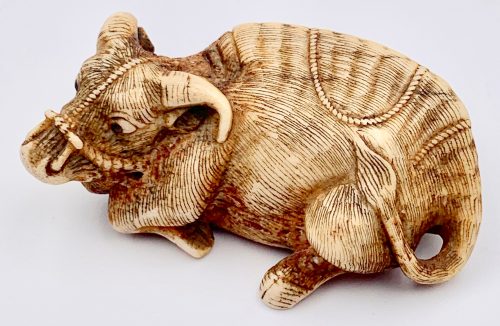 Stag antler netsuke of a recumbent ox. Signed: Tomomasa [友政]. Circa 1800. Dimensions: 56.1 x 20.7 x 36.8 mm Just speculation: There was a master in Kyoto named Tomotada who made netsuke with a recumbent ox motif. Our Tomomasa may be an epigone of a later date. Some even attribute the master to Meiji period. Provenance: Charles Ephrussi (1849-1905) acquired in the 1870s; a wedding gift in 1898 to his cousin Ritter Viktor von Ephrussi (1860-1945) and Baroness Emilie (Emmy) Schey von Koromla (1879-1938); retrieved post-war by their daughter Elizabeth de Waal (1899-1991); given by her to her brother Ignaz (Iggie) Ephrussi (1906-1994), Tokyo; bequeathed by him to his great-nephew Edmund de Waal (born 1964), London, author of “The Hare with Amber Eyes: a hidden inheritance”. London / New York: Chatto & Windus / Farrar, Straus & Giroux. ISBN 978-0099539551. https://en.wikipedia.org/wiki/Charles_Ephrussi. https://en.wikipedia.org/wiki/Ephrussi_family. https://en.wikipedia.org/wiki/Edmund_de_Waal.
Stag antler netsuke of a recumbent ox. Signed: Tomomasa [友政]. Circa 1800. Dimensions: 56.1 x 20.7 x 36.8 mm Just speculation: There was a master in Kyoto named Tomotada who made netsuke with a recumbent ox motif. Our Tomomasa may be an epigone of a later date. Some even attribute the master to Meiji period. Provenance: Charles Ephrussi (1849-1905) acquired in the 1870s; a wedding gift in 1898 to his cousin Ritter Viktor von Ephrussi (1860-1945) and Baroness Emilie (Emmy) Schey von Koromla (1879-1938); retrieved post-war by their daughter Elizabeth de Waal (1899-1991); given by her to her brother Ignaz (Iggie) Ephrussi (1906-1994), Tokyo; bequeathed by him to his great-nephew Edmund de Waal (born 1964), London, author of “The Hare with Amber Eyes: a hidden inheritance”. London / New York: Chatto & Windus / Farrar, Straus & Giroux. ISBN 978-0099539551. https://en.wikipedia.org/wiki/Charles_Ephrussi. https://en.wikipedia.org/wiki/Ephrussi_family. https://en.wikipedia.org/wiki/Edmund_de_Waal. -
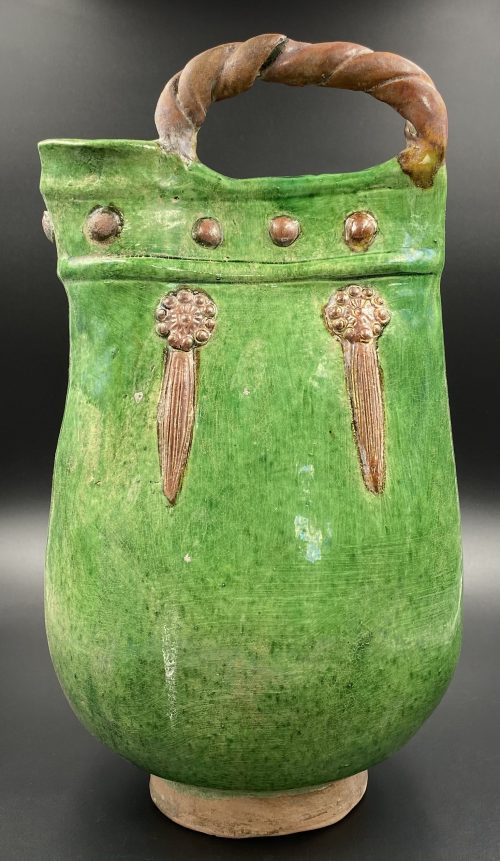 Footed purse-like ewer with twisted handle, with sculptured body glazed in green and details glazed in brown, on an unglazed foot. China, the Liao Dynasty [辽朝] (907 – 1125). Dimensions: 29 x 15 x 15 cm
Footed purse-like ewer with twisted handle, with sculptured body glazed in green and details glazed in brown, on an unglazed foot. China, the Liao Dynasty [辽朝] (907 – 1125). Dimensions: 29 x 15 x 15 cm -
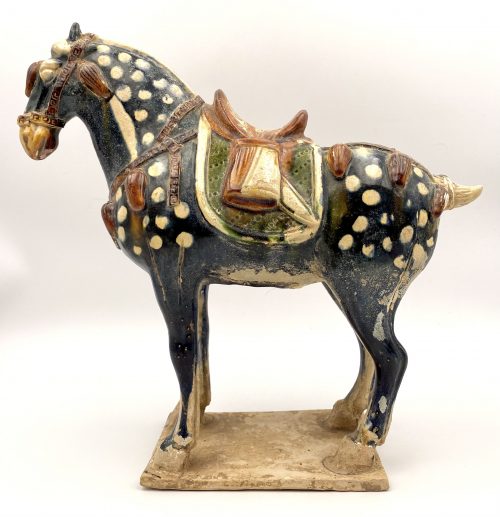 Moulded and sculpted earthenware horse with dark-blue, cream-dappled body, green and cream saddle pad, amber and cream saddle, and amber harness details. H: 28 cm.
Moulded and sculpted earthenware horse with dark-blue, cream-dappled body, green and cream saddle pad, amber and cream saddle, and amber harness details. H: 28 cm. -
 Iron tsuba of mokko form decorated with encircled family crests in low relief carving; niku from 3.0 mm in the centre to 4.0 mm at rim and full 1 mm raised uchikaeshi-mimi. Nobuie [信家] signature (hanare-mei) to the left of nakago-ana; on the reverse, to the right of nakago-ana, the inscription reads “62”, which may be how old the master was at the age of making the tsuba. Pewter or lead plugged hitsuana. In a wooden box, in a custom pouch. Size: H: 80 mm, W: 75, Th(c): 3.1 mm, Th(r): 4.0 mm Weight: 103.5 g
Iron tsuba of mokko form decorated with encircled family crests in low relief carving; niku from 3.0 mm in the centre to 4.0 mm at rim and full 1 mm raised uchikaeshi-mimi. Nobuie [信家] signature (hanare-mei) to the left of nakago-ana; on the reverse, to the right of nakago-ana, the inscription reads “62”, which may be how old the master was at the age of making the tsuba. Pewter or lead plugged hitsuana. In a wooden box, in a custom pouch. Size: H: 80 mm, W: 75, Th(c): 3.1 mm, Th(r): 4.0 mm Weight: 103.5 gSigned: Nobuie [信家] / 62
Probably the work of Shodai Nobuie (c. 1580).
Tokubetsu hozon certificate № 2002993 of the N.B.T.H.K., dated January 15, 2016. NOBUIE TSUBA by Steve Waszak The iron tsuba made by the two early Nobuie masters are regarded as the greatest sword guards ever made across hundreds of years of Japanese history. Only a small handful of other smiths' names are even mentioned in the same breath as that of Nobuie. Despite the well-deserved fame of the Nobuie name, virtually nothing is known with certainty about the lives of the two men who made the pieces carrying this name. They are thought to have been men of Owari Province, with the Nidai Nobuie also spending time in Aki Province at the end of the Momoyama Period. Two Nobuie tsubako are recognized. The man whom most consider to have been the Shodai signed his sword guards with finer and more elegantly inscribed characters than the smith seen by most as the Nidai. The term used to describe the mei of the Shodai is "hanare-mei" or "ga-mei," while that used to characterize the signature of the Nidai is "futoji-mei" or "chikara-mei." These terms refer to the fineness and grace of the Shodai's signature and the relatively more powerfully inscribed characters of the Nidai's. The Shodai is thought to have lived during the Eiroku and Tensho eras in the latter part of the 16th century, while the Nidai's years are considered to have been from Tensho into the Genna era. This locates both smiths well within the Golden Age of tsuba artists -- the Momoyama Period. Nobuie tsuba are esteemed and celebrated for the extraordinary beauty of their iron. The combination of the forging of the metal, the surface treatment by tsuchime and yakite married to powerfully expressive carving, the masterful manipulation of form, mass and shape, and the colour and patina of the iron makes Nobuie sword guards not only unique in the world of tsuba, but the greatest of the great. The sword guard here is a Shodai-made masterwork, done in mokko-gata form, a shape the early Nobuie smiths mastered to a degree unmatched by any others. The expanding of the mass of the tsuba from the seppa-dai to the mimi, increasing by 50% from the centre of the guard to the rim, creates a sense of exploding energy, which is then contained by the uchikaeshi-mimi, yielding a lightning-in-a-bottle effect of captured energy. The hammering the master has employed to finish the surface is subtle and sensitive, achieving a resonant profundity, and the deep blue-black colour -- augmented by a lustrous patina -- leaves the tsuba to positively glow in one's hand. In this piece, Nobuie has used a motif of several kamon, or family crests, each carved only lightly on the surface in a loose ring around the nakago-ana. Due to the shallow depth of this carving, together with the tsuchime finish of the plate, the effect is to leave the kamon with a sort of weathered appearance, recalling the prime aesthetic values of sabi and wabi, which had great circulation in the Tea Culture so ascendant in the Momoyama years. However, the effects of sabi and wabi expressed in the treatment described above are amplified and deepened by the color and patina of the iron, thereby adding yet another aesthetic value -- yuugen -- which is linked with the abiding mystery of the universe and one more — mono no aware — which alludes to the pathos of life's experiences and transitory nature. In short, this Nobuie tsuba joins poetry with power and therein exemplifies the unrivalled brilliance of Nobuie workmanship. -
 Iron tsuba of oval form with design of a gourd or aubergine vine with fruits, leaves, and blossoms climbing a trellis, and a fence in yellow brass and red copper flat inlay (hira-zōgan); inlay engraved. Two latticed windows represented by openwork (sukashi). The iron web has deep black patina. The seller attributes this tsuba to Heianjo-Namban school, whatever it means. Momoyama or early Edo period, 17th century. Kaga or Heianjō School. Unsigned. Height: 77.3, Width: 73.1, Thickness at seppa-dai: 3.6 mm.
Iron tsuba of oval form with design of a gourd or aubergine vine with fruits, leaves, and blossoms climbing a trellis, and a fence in yellow brass and red copper flat inlay (hira-zōgan); inlay engraved. Two latticed windows represented by openwork (sukashi). The iron web has deep black patina. The seller attributes this tsuba to Heianjo-Namban school, whatever it means. Momoyama or early Edo period, 17th century. Kaga or Heianjō School. Unsigned. Height: 77.3, Width: 73.1, Thickness at seppa-dai: 3.6 mm. -
 Iron tsuba of oval form with design of iris and plank bridge (yatsubashi) in openwork (sukashi). Rounded cornered rim. Unsigned. Attributed to Jingo - 3rd generation Shimizu, 2nd generation Jingo (1691-1777) [M. Sesko, Genealogy..., p. 94]. Edo period: Late 18th century (Hohreki / Meiwa era). Height: 69.5 mm. Width: 65.2 mm. Rim thickness: 4.6 mm. Center thickness: 4.8 mm. Provenance: Sasano Masayuki Collection, № 251: "Shimizu. Third generation Jingo (died at 87 years of age in the sixth year of An-ei, 1777). The eight-section bridge with irises are arranged to create the design of 'yatsubashi'. The features are unique for the Shimizu school and show no influence of the Hirita, Nishigaki or Hayashi schools". The design visually resembles a butterfly. As described in Family Crests of Japan by Stone Bridge Press [Family Crests of Japan; Stone Bridge Press, Berkeley, CA, 2007], and also in Japanese Family Crests by Yuzuru Okada [Yuzuru Okada. Japanese Family Crests // Series: Tourist Library: 37. Board of tourist industry; Japanese Government Railways, - 1941], there is a special technique used in construction of family crests, called 'reshaping' by the former and 'reconstruction' by the latter: "reconstruction is realized when a motive has its general shape composed of the detail of entirely different motive as, for instance, the crest of a butterfly formed of pine-needles. [...] The fanciful and ingenious forms evolved in this way may be represented by the kasiwa-giri or 'oak-leaf-paulownia', the ogi-bisi or 'fan-lozenge', the matuba-zuru or 'pine-needle-crane', the omodaka-kotyo or 'water-plantain-butterfly', etc." In our case we can call the motif yatsubashi-chocho or 'Iris-and-Bridge—Butterfly'.
Iron tsuba of oval form with design of iris and plank bridge (yatsubashi) in openwork (sukashi). Rounded cornered rim. Unsigned. Attributed to Jingo - 3rd generation Shimizu, 2nd generation Jingo (1691-1777) [M. Sesko, Genealogy..., p. 94]. Edo period: Late 18th century (Hohreki / Meiwa era). Height: 69.5 mm. Width: 65.2 mm. Rim thickness: 4.6 mm. Center thickness: 4.8 mm. Provenance: Sasano Masayuki Collection, № 251: "Shimizu. Third generation Jingo (died at 87 years of age in the sixth year of An-ei, 1777). The eight-section bridge with irises are arranged to create the design of 'yatsubashi'. The features are unique for the Shimizu school and show no influence of the Hirita, Nishigaki or Hayashi schools". The design visually resembles a butterfly. As described in Family Crests of Japan by Stone Bridge Press [Family Crests of Japan; Stone Bridge Press, Berkeley, CA, 2007], and also in Japanese Family Crests by Yuzuru Okada [Yuzuru Okada. Japanese Family Crests // Series: Tourist Library: 37. Board of tourist industry; Japanese Government Railways, - 1941], there is a special technique used in construction of family crests, called 'reshaping' by the former and 'reconstruction' by the latter: "reconstruction is realized when a motive has its general shape composed of the detail of entirely different motive as, for instance, the crest of a butterfly formed of pine-needles. [...] The fanciful and ingenious forms evolved in this way may be represented by the kasiwa-giri or 'oak-leaf-paulownia', the ogi-bisi or 'fan-lozenge', the matuba-zuru or 'pine-needle-crane', the omodaka-kotyo or 'water-plantain-butterfly', etc." In our case we can call the motif yatsubashi-chocho or 'Iris-and-Bridge—Butterfly'. -
 Iron tsuba of oval form carved and inlaid in gold and copper with cormorant fisherman in disguise. Unsigned. Dimensions: 67.7 mm x 61.5 mm x 3.8 mm (at seppa-dai) Edo period: 18th century. "Since Nara period, Japanese fishermen in small boats have used cormorants (u) to catch river fish at night, binding the necks of the birds so that the fish are not swallowed. [...] The bird and the work it performs are symbols of selfless devotion to one's master and keen eyesight." - from Merrily Baird. Symbols of Japan. Thematic motifs in art and design. Rizzoli international publications, Inc., 2001; p. 104. See also TSU-0212 and TSU-0096
Iron tsuba of oval form carved and inlaid in gold and copper with cormorant fisherman in disguise. Unsigned. Dimensions: 67.7 mm x 61.5 mm x 3.8 mm (at seppa-dai) Edo period: 18th century. "Since Nara period, Japanese fishermen in small boats have used cormorants (u) to catch river fish at night, binding the necks of the birds so that the fish are not swallowed. [...] The bird and the work it performs are symbols of selfless devotion to one's master and keen eyesight." - from Merrily Baird. Symbols of Japan. Thematic motifs in art and design. Rizzoli international publications, Inc., 2001; p. 104. See also TSU-0212 and TSU-0096 -
 Iron tsuba of round form with two overlapping triangles (uroko) motif in openwork (sukashi). Triangle patterns usually associate with 'fish scale', mon of Hojo family (and others). Edo period or later.
Iron tsuba of round form with two overlapping triangles (uroko) motif in openwork (sukashi). Triangle patterns usually associate with 'fish scale', mon of Hojo family (and others). Edo period or later.Size: 71.4 x 70.2 x 5.2 mm.
An association with the Star of David is doubtful if not impossible. -
 Iron tsuba of round form decorated with dragonfly (tombo) and comma (comma-like swirl, tomoe) in openwork (sukashi) outlined with brass wire. The plate decorated with 5 concentric circular rows of brass dots in ten-zōgan. Center of the plate outlined with the inlaid circular brass wire (sen-zōgan). Ōnin school. Unsigned. Mid Muromachi period, middle of the 15th century. Dimensions: Diameter: 89.5 mm, thickness: 3.1 mm. Notes regarding design: "According to various sources, the dragonfly (tombo) is emblematic of martial success, as various names for the insect are homophones for words meaning "victory". The dragonfly is also auspicious because references in the Kojiki and Nihongi link it in both name and shape to the old kingdom of Yamato." [Merrily Baird. Symbols of Japan. Thematic motifs in art and design. Rizzoli international publications, Inc., 2001, p. 108]. "The dragonfly (tonbo), was also called kachimushi in earlier times, and due to the auspicious literal meaning "victory bug" of the characters of this word it became a popular theme on sword fittings." [Iron tsuba. The works of the exhibition "Kurogane no hana", The Japanese Sword Museum, 2014, p. 13]. Helen C. Gunsaulus' description of the dragonfly emblem is as follows: "This motive, the dragon-fly (akitsu), is generally accepted as a symbol of the kingdom of Japan, and the origin of the idea is traced to the legend recounted in the Kojiki and Nihongo of the Emperor Jimmu's view of the island from mountain top. He is said to have thought the kingdom looked like a dragon-fly touching its tail with its mouth. From this it received its name Akitsu-shima... etc."
Iron tsuba of round form decorated with dragonfly (tombo) and comma (comma-like swirl, tomoe) in openwork (sukashi) outlined with brass wire. The plate decorated with 5 concentric circular rows of brass dots in ten-zōgan. Center of the plate outlined with the inlaid circular brass wire (sen-zōgan). Ōnin school. Unsigned. Mid Muromachi period, middle of the 15th century. Dimensions: Diameter: 89.5 mm, thickness: 3.1 mm. Notes regarding design: "According to various sources, the dragonfly (tombo) is emblematic of martial success, as various names for the insect are homophones for words meaning "victory". The dragonfly is also auspicious because references in the Kojiki and Nihongi link it in both name and shape to the old kingdom of Yamato." [Merrily Baird. Symbols of Japan. Thematic motifs in art and design. Rizzoli international publications, Inc., 2001, p. 108]. "The dragonfly (tonbo), was also called kachimushi in earlier times, and due to the auspicious literal meaning "victory bug" of the characters of this word it became a popular theme on sword fittings." [Iron tsuba. The works of the exhibition "Kurogane no hana", The Japanese Sword Museum, 2014, p. 13]. Helen C. Gunsaulus' description of the dragonfly emblem is as follows: "This motive, the dragon-fly (akitsu), is generally accepted as a symbol of the kingdom of Japan, and the origin of the idea is traced to the legend recounted in the Kojiki and Nihongo of the Emperor Jimmu's view of the island from mountain top. He is said to have thought the kingdom looked like a dragon-fly touching its tail with its mouth. From this it received its name Akitsu-shima... etc." -
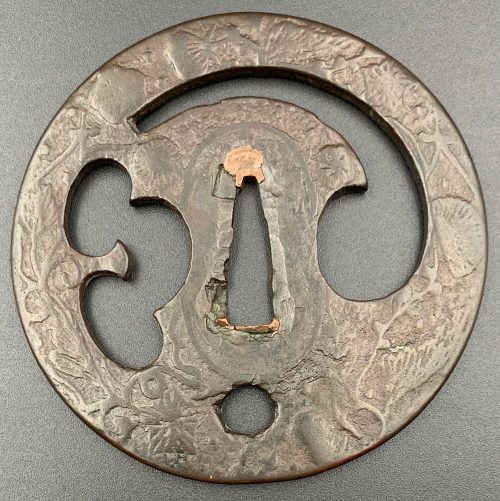
Yamagane (bronze) tsuba (kagami-shi, or mirror-maker) with the design of a star (round opening), tomoe (comma), and suhama in openwork. Surface cast and chiselled with the design of foliage, vines, blossoms, pine needles, and fruits on both sides.
The end of Early Muromachi period (1393-1453), circa 1450. Size: 83.7 x 84.1 x 3.6 (center), 4.1 (rim) mm; weight: 135.5 g. KANTEI-SHO (鑑定書) - APPRAISAL [translated by Markus Sesko]. No 463341 Tomoe-suhama-sukashi hana-karakusa no zu tsuba (巴洲浜透花唐草図鐔) ‒ Tsuba with stylized comma and bay inlet openwork and a flower and arabesque décor Unsigned: Kagami-shi (鏡師) Round shape, yamagane, hammer blow finish, cast, negative openwork design, round rim. According to the result of the shinsa committee of our society, we judge this work as authentic and rank it as Hozon Tōsōgu. July 1, 2011 [Foundation] Nihon Bijutsu Tōken Hozon Kyōkai, NBTHK (日本美術刀劍保存協會) -
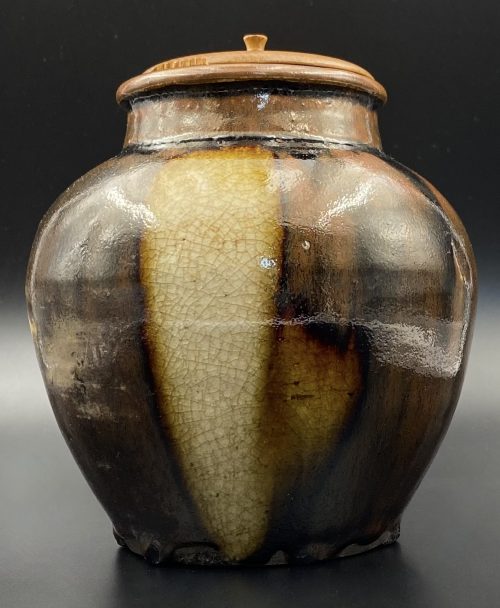 Seller's description: "pottery jar presenting a circular, concave base, an apple-form body, a cylindrical neck, and an annular flared rim. Boasting a lustrous burnish, the gorgeous vessel displays three narrow vertical panels in a hue of cream over mottled shades of chocolate brown and mocha on its body and a caramel-coloured neck and rim. The discoid lid features a lovely natural woodgrain surface incised with three decorative concentric circles around a petite knob-like handle. Note the beautiful globules of glaze that decorate the periphery of the base! This type of vessel is known as Seto ware." Size: Dia: 13 cm, H: 14 cm.
Seller's description: "pottery jar presenting a circular, concave base, an apple-form body, a cylindrical neck, and an annular flared rim. Boasting a lustrous burnish, the gorgeous vessel displays three narrow vertical panels in a hue of cream over mottled shades of chocolate brown and mocha on its body and a caramel-coloured neck and rim. The discoid lid features a lovely natural woodgrain surface incised with three decorative concentric circles around a petite knob-like handle. Note the beautiful globules of glaze that decorate the periphery of the base! This type of vessel is known as Seto ware." Size: Dia: 13 cm, H: 14 cm. -
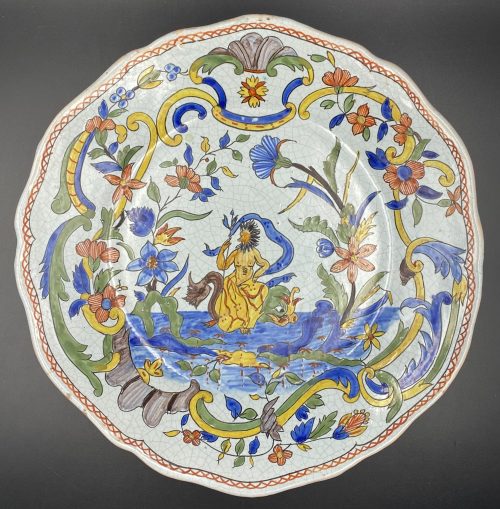 Tin-glazed earthenware polychrome plate with a scalloped rim, decorated with a triton riding a dolphin, surrounded by flowers and arabesque. Diameter: 24.5 cm; Height: 3.5 cm.
Tin-glazed earthenware polychrome plate with a scalloped rim, decorated with a triton riding a dolphin, surrounded by flowers and arabesque. Diameter: 24.5 cm; Height: 3.5 cm. -
 Signature: Unsigned
Signature: UnsignedFuchi-kashira with rock and boar (iwa ni inoshishi zu) motif. Inlay of precious stones or colour glass. Shakudō, gold, gemstones. Technique: Sukibori zogan kiniroe.
Fuchi: 36 x 21 x 14 mm; Weight: 22 g; Kashira: 32 x 17 x 5 mm; Weight: 8 g; Material : Shakudō; Gold; Gemstones (Chalcedony and Rose Quartz). Possibly, Owari school. -
 Iron tsuba of round form with slanting rays of light (shakoh) Christian motif (Jesuit’s IHS symbol) in openwork (sukashi). Traditional description of this kind of design is called “tokei”, or “clock gear”. Signed: On the face: Bushu ju Akasaka; On the back: Tadatoki Saku [Made by Tadatoki, resident of Bushu]. Probably, 4th generation of Akasaka School master Tadatoki (忠時), who died in 1746. Akasaka School. Edo period, first half of the 18th century. Size: 79.8 x 78.5 x 6.5 mm
Iron tsuba of round form with slanting rays of light (shakoh) Christian motif (Jesuit’s IHS symbol) in openwork (sukashi). Traditional description of this kind of design is called “tokei”, or “clock gear”. Signed: On the face: Bushu ju Akasaka; On the back: Tadatoki Saku [Made by Tadatoki, resident of Bushu]. Probably, 4th generation of Akasaka School master Tadatoki (忠時), who died in 1746. Akasaka School. Edo period, first half of the 18th century. Size: 79.8 x 78.5 x 6.5 mm -
 Iron tsuba of six-lobed (mutsu-mokkō-gata) form, with six wild boar's eye shape (inome) openings (sukashi). Hitsu-ana and the entire perimeter of tsuba have typical for this school raised rim. Lobes are decorated with landscape motifs in low relief carving (sukidashi-bori). On the obverse: A hut under a full moon, Shinto shrine gates (torii) with pines and a full moon, rocks, a large pine tree, and a temple (pagoda) surrounded by rocks and waves. On the reverse: waves, fishing boat, wild gees in flight under full moon, maple, hexagon (tortoiseshell, kikko) with a dot inside and a dot outside (inclusion/exclusion symbol), and chrysanthemum (the last two may be family crests, mon). Kamakura-bori school. Late Muromachi period (1514-1573). Height: 64.2 mm, width: 74.3 mm, Thickness at seppa-dai: 3.2 mm, at rim 2.6 mm. Weight: 62.8 g (light). NBTHK old green certificate №561: Tokubetsu Kicho - "Extraordinary Work". A look-a-like tsuba can be found at the Compton Collection, part II, pp. 14-15, №17, though his tsuba is more massive (80 x 84 x 4 mm).NBTHK paper says that the motif is Hakkei (八景), i.e. "Eight Views," so several interpretations are possible (the original Chinese ones, Omi Hakkei, etc.). However, most likely it is the 'Eight views of Omi' (近江八景 - 'Omi Hakkei'). Why the artist selected a 6-lobed form for depicting 8 views remains unclear, and thus we are in our right to raise the question whether the motif is indeed Hakkei. The term Omi hakkei (eight views of Omi) refers to painting or print sets which illustrate life on the shores of Lake Biwa in Omi (now Shiga Prefecture). The model for such paintings came from China, where, from the eleventh century onward, painters had produced eight views of the Hsiao and Hsiang lake areas of Hunan Province. The themes, which follow the original Chinese models, are: geese descending to land, returning fishing boats, clearing rain, a snow-covered evening landscape, the autumn moon, night rain, a temple bell at evening, and the glow of sunset. Japanese artists have also used the eight-theme approach for other parts of country - including cities - and applied it to subject matter other than landscapes. [Merrily Baird. Symbols of Japan. Thematic motifs in art and design. Rizzoli international publications, Inc., 2001, page 308-9]. Japan Encyclopedia by Louis Frédéric also mentions Omi Hakkei as "Eight landscapes of Omi", and states that this theme was often cited in poetry after 1500. It is likely that the tsuba in focus is designed under the influence of the theme popularity in the 16th century. The theme was effectively exploited by prominent ukiyo-e artists Suzuki Harunobu and Utagawa Hiroshige in the 18th and 19th century, respectively. These are the eight scenes of the theme (see Wikipedia):
Iron tsuba of six-lobed (mutsu-mokkō-gata) form, with six wild boar's eye shape (inome) openings (sukashi). Hitsu-ana and the entire perimeter of tsuba have typical for this school raised rim. Lobes are decorated with landscape motifs in low relief carving (sukidashi-bori). On the obverse: A hut under a full moon, Shinto shrine gates (torii) with pines and a full moon, rocks, a large pine tree, and a temple (pagoda) surrounded by rocks and waves. On the reverse: waves, fishing boat, wild gees in flight under full moon, maple, hexagon (tortoiseshell, kikko) with a dot inside and a dot outside (inclusion/exclusion symbol), and chrysanthemum (the last two may be family crests, mon). Kamakura-bori school. Late Muromachi period (1514-1573). Height: 64.2 mm, width: 74.3 mm, Thickness at seppa-dai: 3.2 mm, at rim 2.6 mm. Weight: 62.8 g (light). NBTHK old green certificate №561: Tokubetsu Kicho - "Extraordinary Work". A look-a-like tsuba can be found at the Compton Collection, part II, pp. 14-15, №17, though his tsuba is more massive (80 x 84 x 4 mm).NBTHK paper says that the motif is Hakkei (八景), i.e. "Eight Views," so several interpretations are possible (the original Chinese ones, Omi Hakkei, etc.). However, most likely it is the 'Eight views of Omi' (近江八景 - 'Omi Hakkei'). Why the artist selected a 6-lobed form for depicting 8 views remains unclear, and thus we are in our right to raise the question whether the motif is indeed Hakkei. The term Omi hakkei (eight views of Omi) refers to painting or print sets which illustrate life on the shores of Lake Biwa in Omi (now Shiga Prefecture). The model for such paintings came from China, where, from the eleventh century onward, painters had produced eight views of the Hsiao and Hsiang lake areas of Hunan Province. The themes, which follow the original Chinese models, are: geese descending to land, returning fishing boats, clearing rain, a snow-covered evening landscape, the autumn moon, night rain, a temple bell at evening, and the glow of sunset. Japanese artists have also used the eight-theme approach for other parts of country - including cities - and applied it to subject matter other than landscapes. [Merrily Baird. Symbols of Japan. Thematic motifs in art and design. Rizzoli international publications, Inc., 2001, page 308-9]. Japan Encyclopedia by Louis Frédéric also mentions Omi Hakkei as "Eight landscapes of Omi", and states that this theme was often cited in poetry after 1500. It is likely that the tsuba in focus is designed under the influence of the theme popularity in the 16th century. The theme was effectively exploited by prominent ukiyo-e artists Suzuki Harunobu and Utagawa Hiroshige in the 18th and 19th century, respectively. These are the eight scenes of the theme (see Wikipedia):
Compton Collection, part II, pp. 14-15, №17: Kamakura-bori tsuba, ca. 1450.
- Returning sails at Yabase (矢橋の帰帆) - Yabase. Yabase is an old harbour on the east side of the lake. Near the Tokaido, it was used for a shortcut to Otsu by boat.
- Evening glow at Seta (勢多(瀬田)の夕照) - The Chinese Bridge at Seta. The long bridge across the Seta was used by the Tokaido. In the background the "Fuji of Omi", the Mikamiyama. It is just above 400 m, but indeed well visible.
- Autumn moon at Ishiyama (石山の秋月) - Ishiyama Temple. The Ishiyamadera was located on a hillside next to the Seta River. It got his name form the strange rocks on which it is built, partly on supporting beams. A hut at the upper end of the site allows a view of the lake, and the moon.
- Clear breeze at Awazu (粟津の晴嵐) - Awazuhara. Awazu is well known for its pine wood, Awazu-ga-hara.
- Evening bell at Miidera (三井晩鐘) - Mii-dera. Miidera temple was built in the 8th century. Its famous bell is one of the "Three bells of Japan", the other two being those at Byoodo-in, Uji and at Jingoji, Kyoto.
- Evening rain at Karasaki (唐崎の夜雨) - Karasaki Shrine. Karasaki is a small cape with a single large pine tree, a hitsu-matsu.
- Wild geese returning home at Katata (堅田の落雁) - Ukimido. Alighting geese cannot be seen always, however the little temple near Katata in the square hōkyō-style, detached from the lakeside, connected by a bridge. The first part of the name uki is the same as in Ukiyo-e, meaning floating. Midō means temple.
- Evening snow at Hira (比良の暮雪) - Hira Mountains. The Hira mountains on the west side of the lake experience the hard winter, when the winter monsoon brings much snow from the continent.
-
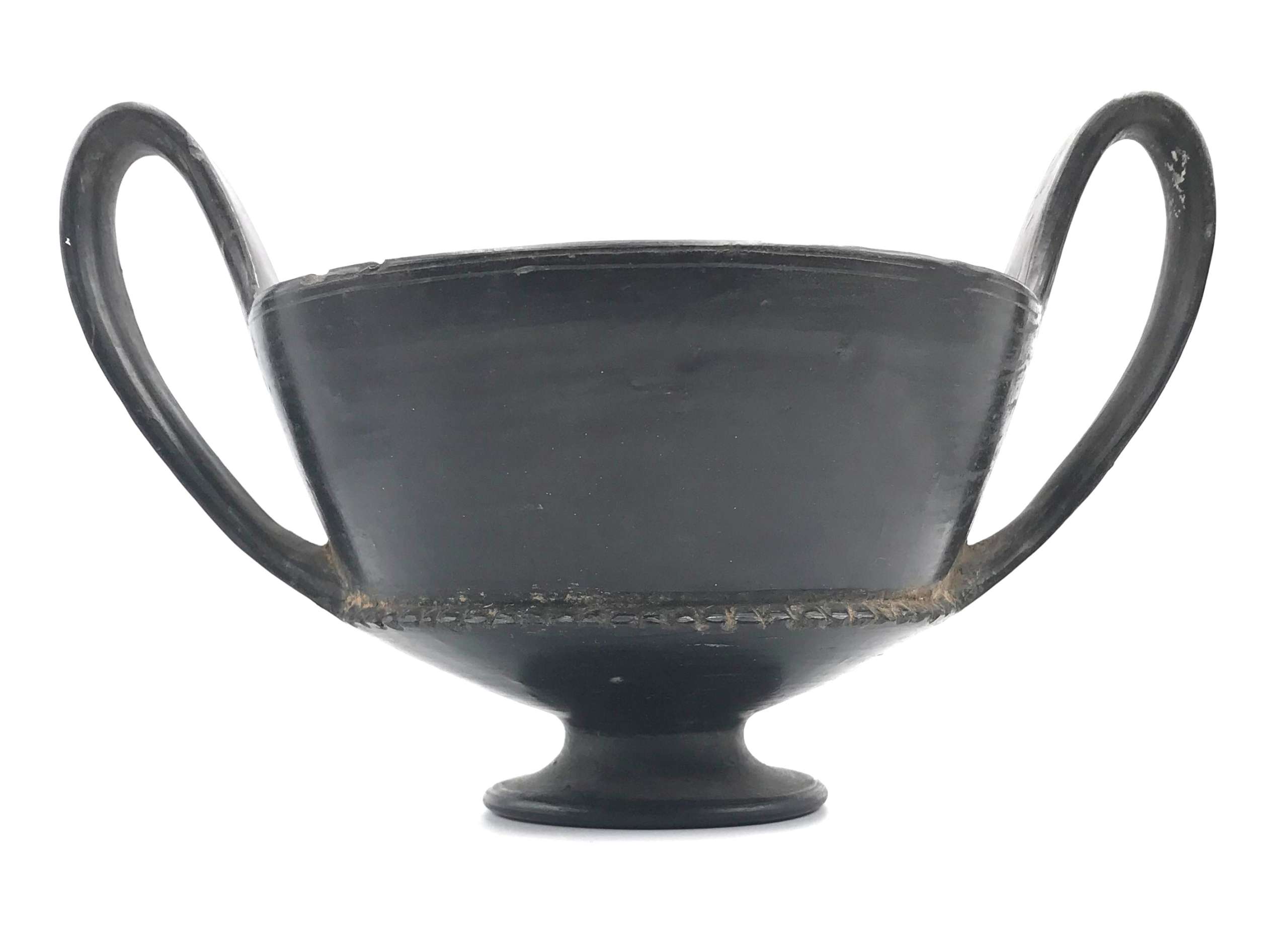 Etruscan Bucchero Pottery Kantharos, ca. 758-264 BC. A ceramic vessel with high handles, meant for consuming wine. Flanged border between the body and the foot displays dozens of incised grooves. The rim is smooth, and the upper and of each handle flows seamlessly into the body if the vessel. Bucchero is an Etruscan type of pottery named for the specific firing technique which results in a smooth, shiny black finish. Size: 21.6 x 13.3 cm. Portions os both handles repaired with some overpainting and light adhesive residue along break lines, One handle stabilized with some new material and overpainting along fissure line. Light earthen deposits within recessed areas.
Etruscan Bucchero Pottery Kantharos, ca. 758-264 BC. A ceramic vessel with high handles, meant for consuming wine. Flanged border between the body and the foot displays dozens of incised grooves. The rim is smooth, and the upper and of each handle flows seamlessly into the body if the vessel. Bucchero is an Etruscan type of pottery named for the specific firing technique which results in a smooth, shiny black finish. Size: 21.6 x 13.3 cm. Portions os both handles repaired with some overpainting and light adhesive residue along break lines, One handle stabilized with some new material and overpainting along fissure line. Light earthen deposits within recessed areas. -

Iron tsuba of mokkō form (mokkōgata) pierced (sukashi) and inlaid with precast dark brass inlay (taka-zōgan) with somewhat abstract/geometrical design that can be liberally described as pines, mist, and snow.
Momoyama or early Edo period. End of the 16th - beginning of the 17th century. Heianjō school. Unsigned. Dimensions: 86.8 x 82.9 x 4.5 mm. -

A very thin kobushi-gata form iron tsuba decorated in openwork (sukashi), some openings filled with grey metal (silver or pewter) treated in a way to resemble cracked ice, ginkgo leaf to recto and plum blossoms to verso in low-relief (takabori) and gold inlay (zōgan), and unevenly folded over rim (hineri-mimi). The overall theme of the piece is linked to the icy ponds, falling ginkgo leaves and blossoming plums in the late winter.
Size: 84 x 80 mm, thickness (center): 2 mm.Signed: Yamashiro no kuni Fushimi no ju Kaneie [Kaneie of Fushimi in Yamashiro Province] [山城國伏見住金家], with Kaō.
Probably the work of Meijin-Shodai Kaneie (c. 1580 – 1600).
The silver or pewter inlays likely a later work that may be attributed to Goto Ichijo (1791 – 1876) or one of his apprentices in the late 19th century, possibly as a tribute to the great Kaneie masters. Here is an article by Steve Waszak dedicated to Kaneie masters and this tsuba in particular.Kaneie
For many tosogu aficionados, this name reigns supreme among all tsubako across Japanese history. The first Kaneie is celebrated for many things. He is recognized as being the first ever to bring pictorial landscape subjects to a canvas so small as that of a tsuba plate. His skill in being able to render classical Chinese landscape themes while working with a material as unyielding as steel, and to do so with the sensitivity he does, is nothing short of astounding. The quality of his workmanship — especially that of his exquisitely carved motif elements and the extraordinary deftness of his tsuchime (槌目 or 鎚目, hammer-blow) utilizing such thin plates — astonishes even to this day. His sensibilities concerning the shaping of his sword guards and the presentation of the rims were no less innovative than his subject matter. He was among the very first to regularly sign his name as a tsuba smith. And it is likely that he served the great warlord Toyotomi Hideyoshi in the latter years of the 16th century. Despite the great fame and reputation of Kaneie, very little of the lives of the two men who are seen by most scholars as the “true Kaneie” tsubako of the Momoyama and earliest Edo Periods is known to us now. They were both smiths working in steel, with occasional added soft-metal inlay (usually serving to highlight features), and both made sword guards of the same style, using subject matter focused on landscapes, allusions to historical events, or religious themes. The first of these men is often referred to as “O-Shodai,” or Great First Generation, while the second is known as “Meijin-Shodai,” or Famous First Generation. While some see subsequent generations stemming from these first two men, others have the O-Shodai and the Meijin-Shodai as THE two true Kaneie and make a sharp distinction between these two smiths and any others who may share the name.The work of the O-Shodai may appear with two different mei. One of these is written “Joshu Fushimi Ju Kaneie,” while his work may also carry a mei reading “Yamashiro no Kuni Fushimi Ju Kaneie.” It is thought by some scholars that the earlier works present with the “Joshu” mei, while his later works feature the “Yamashiro” mei. However, there are only some five or six tsuba extant with the “Joshu” signature, so we should not necessarily see works with the “Yamashiro” signature as dating only to the latest years of his working life. The answers to the questions of exactly when Kaneie might have begun his life as a tsubako, or how old he was when he moved to sign his works with the “Yamashiro” mei, will probably remain shrouded in uncertainty.The association between Kaneie and Toyotomi Hideyoshi is speculative, to be sure, but the circumstantial evidence is tantalizing. The area of Fushimi is thought to have been an entirely unremarkable land prior to Hideyoshi’s building of a castle there, so it would seem unlikely that the first Kaneie would have been working in such a nondescript place, much less including the place name in his mei, before Hideyoshi’s putting it on the map, so to speak. Why emphasize such pride of place in one’s signature unless the place itself carries a certain weight? The name “Kaneie” translates roughly to “gold family,” which, given Hideyoshi’s notorious love of gold, would seem too much of a coincidence when combined with the explicit mention of Fushimi in the signatures. Combine this with the consideration of what is an equally compelling relationship between the celebrated tsubako Nobuie and Oda Nobunaga (“Nobuie” means roughly “of the family of “Nobu”), whom Hideyoshi served as a top general until Oda’s demise in 1582, and the circumstantial evidence becomes even harder to deny the plausibility of. Oda, ever the innovator, may have been the one responsible for birthing the practice of tsubako regularly signing their works. Having a superb smith like Nobuie affix the name to the tsuba as a regular practice establishes a sort of “brand name,” a brand coming with the seal of approval of Oda Nobunaga. It is more than possible that Nobunaga may have then used these valuable sword guards as rewards given to vassals and other important relations to honour them for their services to him, a practice that would have allowed Nobunaga to avoid having to use gold, guns, swords, horses, or land to do so. The awarding of a magnificent Nobuie tsuba to a deserving warrior, an appreciated ally, or a family member would bring honour to the recipient, of course, but would also honour the maker of the sword guard, and even the giver of the object. Such a way of thinking would be absolutely typical of him, and given that both Oda Nobunaga and Nobuie were men of Kiyosu in Owari in the early Momoyama Period, it does not strain credulity to imagine that the above dynamic could have occurred in just this way. If indeed it did, Toyotomi Hideyoshi is unlikely to have let this pass unnoticed. He may even have been so honoured himself! When he rose to power very shortly after Oda’s death, then, and when he reinforced and consolidated that power in the late 1580s and early 1590s, which included the building of the castle at Fushimi, perhaps he sought to emulate the Oda vision and practice of establishing a “royal tsubako.” If so, Kaneie would have been that smith.As noted, this scenario is speculative, and not a little romantic. This does not mean, however, that it is in fact not likely, for there would be a number of coincidences involved for it to be entirely false.Tsuba scholars will say that Kaneie’s skills in the making of his sword guards indicate an armour-making background. This is an interesting viewpoint, but one can’t help but wonder how many armourers were possessed of such fluent literacy in lyrical Chinese historical tales that they could then represent them as motifs on steel plates. Kaneie subjects often are in the form of Chinese landscapes and allusions, as noted, one of which — The Eight Views of the Xiao and the Xiang — was very well known as a famous subject of Chinese painting and poetry from the Song Dynasty. There exist Kaneie tsuba which depicts at least some of these “views,” and it seems unlikely that if one or more of them were to be created, not all of them would be, in a sort of “series.” The cultural and literary fluency Kaneie would seem to have had, then, may suggest a Buddhist background, and indeed, some of the subjects seen are explicitly Buddhist in nature. Perhaps his background then, somehow offering a dovetailing of metalwork and Buddhist teachings; in any event, we are all the richer for at least some of the works of Kaneie to have survived to reach us today.One of the hallmarks of Kaneie tsuba (real ones) is the extreme thinness of the plate, combined with utterly superb tsuchime expression of that plate. To be able to hammer the plate to achieve such strength of expression while the plate is so thin is seen by the Japanese as practically miraculous. A notable and important kantei point between the early masterpieces by the two “Shodai” Kaneie and the tsuba made by followers is this thinness of the plate. Another kantei point: because the plate is so thin when raised areas representing motif elements are present, they are inlaid into the plate, because trying to carve them from such a thin plate would be practically impossible: the likelihood of piercing the plate would be high, and the plate in that area, even if not pierced, would be significantly weakened by trying to manage the raising of a motif element from the plate. In real Kaneie works, then, one would expect any raised motif elements to be inlaid.Other highlights: the “Shodai” Kaneie are famous for the kobushi-gata (拳形) or “fist-shaped” design in their work, but despite this, there actually aren’t that many extant sword guards boasting this shape. Another feature for which the Kaneie are justly famous is their folding over of the lip of the rim onto the plate in a very tasteful manner, just here and there, rather than uniformly across the tsuba. However, again, this feature is actually not commonly seen, either. The combination, then, of a kobushi-gata shape with the rim folded over in just a few areas is that much rarer.Which brings us to the featured piece.Here is a Kaneie tsuba, a “Meijin-Shodai” Kaneie, which presents with a very thin plate, being between 1.5 and 2mm in thickness. The motif elements are inlaid, as we should expect. The sugata (姿, shape) is Kobushi-gata with the rim folded over in only a few places, representing a relatively infrequently encountered form, as stated. The tsuba here is fortunate not to have any added hitsu-ana, unlike many or most other Kaneie do. The sukashi elements are fascinating to consider, being difficult to determine the meaning of; however, the raised elements clearly point to a seasonal motif, with cherry and plum blossoms on the omote for Spring, and ginkgo on the ura for Fall. The inlaid metal in two of the openings — silver, shibuichi, or pewter, perhaps — is very likely a later addition, probably 19th-century, and more specifically, late-19th-century. The finishing on these inlaid portions has all the hallmarks of Goto Ichijo workmanship. Namely, the treatment of the surface of the inlay to resemble fallen snow (in the Japanese sense of things) is expressed in a very Ichijo sense of things, and, given the great importance of Kaneie tsuba, and the seasonal expression the motif of the guard has, it is plausible that the inlay is Ichijo work or that of one of his top students. In any event, this inlay complements the rest of the tsuba beautifully. The inlay also resembles the art of kintsugi (金継ぎ, golden joinery) or the Japanese practice of ceramic repair using lacquer when a piece is particularly special or important. In this way, a nod is given to Tea Culture, too, creating a wonderful blending of associations and allusions, typical of the highest Japanese aesthetic sense.At 8.4cm, the tsuba is of an excellent size and is in great condition (no rust, no deep rust pitting, no fire damage). There is, intriguingly, one small sign of battle damage at 6:00 on the guard: it would seem a sword blow cut into the tsuba at the rim, and penetrated slightly into the plate. The superb repair represented by a little stitch or two right at the rim and along a few millimetres of the plate is visible on very close inspection. The repair is old, probably nearly contemporary with when the tsuba was made. Given the high status of Kaneie in their lifetime (as tsubako for Hideyoshi, one might imagine their importance), and given the obvious high quality of this piece, it is not surprising that the finest repair efforts were put into its care.The name Kaneie justly enjoys its fame and accolades as pre-eminent among the tens of thousands of tsubako in Japanese history. We are fortunate indeed to have had a small number of the works of the early masters survive to this day. The first of their kind, and as most scholars and aficionados would wholeheartedly agree, the best of their kind, Kaneie sword guards remain among the very finest examples of the Japanese metal-working traditions. -
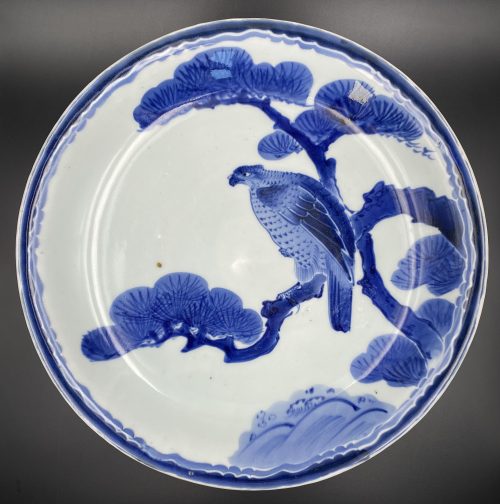 Underglaze cobalt blue and white porcelain plate decorated with a falcon on a pine tree and rough waves beneath; rim with a stylized wave design; seven spur marks on the reverse. Diameter: 31 cm; Height: 5 cm; Diameter of the foot: 18 cm.
Underglaze cobalt blue and white porcelain plate decorated with a falcon on a pine tree and rough waves beneath; rim with a stylized wave design; seven spur marks on the reverse. Diameter: 31 cm; Height: 5 cm; Diameter of the foot: 18 cm. -
 Iron tsuba of the round form (丸型, maru–gata), decorated with brass flat inlay (平象嵌, hira-zōgan) of bellflowers, leaves, and vines on both sides, inlaid brass is carved in low relief; wide rim (dote-mimi) also inlaid; the plate is pierced with hitsu-ana (probably original); nakago-ana plugged with copper sekigane. Dimensions: Height: 84.1 mm; Width: 82.0 mm; Thickness (centre): 2.8 mm; mimi is 11.8 mm wide and 4.7 mm thick. Produced at the end of the 16th century, in the Momoyama period (1674–1703).
Iron tsuba of the round form (丸型, maru–gata), decorated with brass flat inlay (平象嵌, hira-zōgan) of bellflowers, leaves, and vines on both sides, inlaid brass is carved in low relief; wide rim (dote-mimi) also inlaid; the plate is pierced with hitsu-ana (probably original); nakago-ana plugged with copper sekigane. Dimensions: Height: 84.1 mm; Width: 82.0 mm; Thickness (centre): 2.8 mm; mimi is 11.8 mm wide and 4.7 mm thick. Produced at the end of the 16th century, in the Momoyama period (1674–1703). -
 Iron tsuba of round form decorated with eight circular emblems of flowers and/or family crests (mon) made of cast brass, pierced and chiseled in kebori, as well as with flat brass inlay (hira-zōgan) of vines, leaves, and flowers all over the plate. Yoshirō school (Kaga-Yoshirō). The Momoyama or early Edo period, 17th century. Size: diameter 80 mm, thickness at seppa-dai 3,6 mm. Symbols: [12:00 o'clock] - Wood sorrel (katabami) and swords ; [9:00] - Cherry blossom (sakura); [7:30] - Bellflower (kikyō), kamon of Toki clan; [3:00] - possibly, a six-petal Chrysanthemum (kiku) or a Passion flower (tessen); [1:30] - Hemp (asanoha). The symbols at 6:00, 10:30, and 4:30 o'clock seem to be geometrical patterns of auspicious meaning: a cross in a square, a four pointing star, and a diamond, respectively. Alternatively, we may look at this piece as purely decorative, with patterns at 12:00, 3:00, 6:00, and 9:00 o'clock in negative openwork (in-sukashi), and at 1:30, 4:40, 7:20, and 10:30 o'clock - in positive openwork (ji-sukashi, or yō-sukashi). Markus Sesko in his Handbook of sword fittings related terms [Herstellung und Verlag: Books on Demand GmbH, Norderstedt, 2011] discriminates this type of openwork in a separate class: Ranma-sukashi: "This term is applied to circular sukashi with family crests to their inside, which are arranged running along the rim area. The description goes back to the opened boards (ranma) between the sliding doors and the ceiling of Japanese rooms. Ranma-sukashi are mostly seen on old Heianjō- or Yoshirō-zōgan-tsuba but also on works of Hayashi Matashichi" [page 30].
Iron tsuba of round form decorated with eight circular emblems of flowers and/or family crests (mon) made of cast brass, pierced and chiseled in kebori, as well as with flat brass inlay (hira-zōgan) of vines, leaves, and flowers all over the plate. Yoshirō school (Kaga-Yoshirō). The Momoyama or early Edo period, 17th century. Size: diameter 80 mm, thickness at seppa-dai 3,6 mm. Symbols: [12:00 o'clock] - Wood sorrel (katabami) and swords ; [9:00] - Cherry blossom (sakura); [7:30] - Bellflower (kikyō), kamon of Toki clan; [3:00] - possibly, a six-petal Chrysanthemum (kiku) or a Passion flower (tessen); [1:30] - Hemp (asanoha). The symbols at 6:00, 10:30, and 4:30 o'clock seem to be geometrical patterns of auspicious meaning: a cross in a square, a four pointing star, and a diamond, respectively. Alternatively, we may look at this piece as purely decorative, with patterns at 12:00, 3:00, 6:00, and 9:00 o'clock in negative openwork (in-sukashi), and at 1:30, 4:40, 7:20, and 10:30 o'clock - in positive openwork (ji-sukashi, or yō-sukashi). Markus Sesko in his Handbook of sword fittings related terms [Herstellung und Verlag: Books on Demand GmbH, Norderstedt, 2011] discriminates this type of openwork in a separate class: Ranma-sukashi: "This term is applied to circular sukashi with family crests to their inside, which are arranged running along the rim area. The description goes back to the opened boards (ranma) between the sliding doors and the ceiling of Japanese rooms. Ranma-sukashi are mostly seen on old Heianjō- or Yoshirō-zōgan-tsuba but also on works of Hayashi Matashichi" [page 30].


